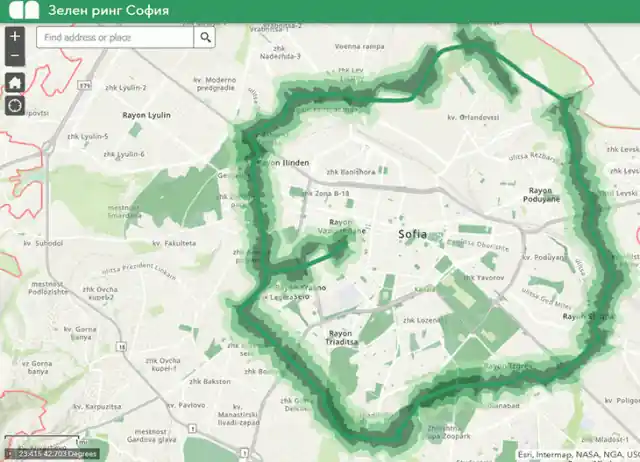
Sofia, Bulgaria – In a transformative move for the city’s urban landscape, municipal councilor Vili Lilkov has announced the development of a 30-kilometer green ring on the former ring railway route, which has been disused for years.
This ambitious project aims to repurpose the old railway line into a vibrant space for pedestrians and cyclists, complete with children’s playgrounds, green areas, and various recreational facilities.
A Vision for a Greener Sofia
Lilkov elaborated on the project’s scope, which involves the removal of old railway tracks to create a continuous ring around Sofia’s central area.
This ring will not only serve as a pedestrian and bicycle path but will also be enhanced with green spaces, sports and playground facilities, sculptures, open-air museum exhibits, observation decks, and additional afforestation.
The initiative promises to transform the urban environment, providing a refreshing and sustainable alternative to the city’s existing infrastructure.
Integration with Existing Infrastructure
One of the key features of the green ring is its integration with existing radial roads.
This will allow cyclists and pedestrians to traverse the city more efficiently, accessing various parks such as Borisova gradina, the Slatinska River area, and Zapaden Park.
The route is also designed to intersect several rivers, adding scenic beauty and natural elements to the urban pathway.
Project Timeline and Ownership
Lilkov expressed optimism about the project’s timeline, stating that a significant portion of the green ring could be realized by the end of the current municipal mandate.
Currently, the municipality owns about 10 kilometers of the route, stretching from “Hladilnika” to “Poduyane” station.
The remaining 20 kilometers, however, need to be transferred from state ownership to municipal control. This transfer is crucial for the project’s completion and the realization of its full potential.
Revitalizing Historical Sites
The former “Pioneer” station, which is now under local government ownership, is planned to be transformed into a sports complex.
Additionally, there is an idea to establish a museum dedicated to the old ring line. This museum would showcase lattice towers, railway infrastructure, and semaphores, preserving the historical significance of the railway while repurposing it for modern use.
Landscaping and New Attractions
In a related development, Lilkov mentioned that the site of the old amusement park in Sofia is intended for landscaping and new attractions.
However, this part of the project is contingent on a change in the land status by its owner, which remains a key step for its progress.
Relocation and Urban Development
To make way for new parks and gardens, the plan includes relocating the traffic police from “Lachezar Stanchev” to the outskirts of “Nadezhda.”
This relocation is expected to free up valuable urban space, contributing to the overall green initiative and enhancing the city’s livability.
Detailed Route of the Green Ring
The green ring project will commence at “Hladilnika,” passing through Borisova gradina and a former freight station before crossing “Simeonovsko shosse.”
It will then continue past the former “Pioneer” station and the “Yug” bus station, and along the Dragovichka River. The route will extend near the psychiatric clinic, traverse under “Tsarigradsko shosse,” and circle around KAT grounds.
It will pass through the Neolithic settlement in “Slatina,” cross “Shipchenski Pass,” and end at Slatin Hill. From there, the path will head towards the “Poduyane” cargo station, follow the old train line through “Central Station,” and pass through “Krasna Polyana” and “Zaharna Fabrika,” finally returning to the “Ivan Vazov” market, where a narrow-gauge railway once operated.
Community Impact and Environmental Benefits
The green ring is expected to have a significant positive impact on the community and the environment. By providing a dedicated space for pedestrians and cyclists, the project encourages healthier lifestyles and reduces reliance on motor vehicles.
The increased green spaces and afforestation efforts will contribute to better air quality and urban biodiversity, creating a more sustainable and enjoyable city environment.
Public Support and Future Prospects
Public support for the green ring project has been growing, with many residents expressing enthusiasm for the proposed changes.
The integration of historical sites and modern recreational facilities has been particularly well-received, highlighting the project’s potential to blend Sofia’s rich history with its future development.
As the municipality works to acquire the remaining land and finalize plans, the green ring project stands as a symbol of Sofia’s commitment to sustainable urban development.
By repurposing disused infrastructure and creating new public spaces, the city is taking significant steps towards a greener, more connected, and more vibrant urban future.
Conclusion
The announcement of the 30-kilometer green ring marks a pivotal moment for Sofia. With its blend of historical preservation, modern amenities, and environmental benefits, the project promises to redefine urban living in the Bulgarian capital.
As the city moves forward with this ambitious plan, residents and visitors alike can look forward to enjoying a transformed urban landscape that prioritizes sustainability, health, and community well-being.
This article was created using automation technology and was thoroughly edited and fact-checked by one of our editorial staff members
